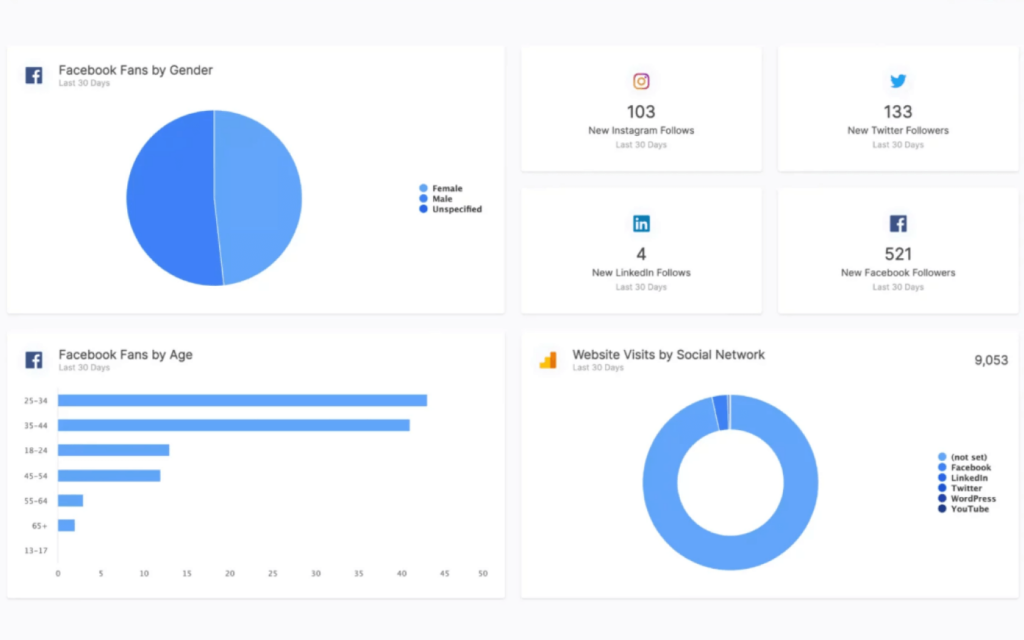Table of Contents
Creating Digital Marketing Reports that Deliver Actionable Results
In our data-rich era, digital marketing teams live and die by the reports they produce. Converting torrents of consumer signals, campaign statistics, and platform insights into strategic clarity separates the best from the rest.
However, creating truly impactful reports extends far beyond just compiling metrics. Best-in-class presentations blend art and science across dimensions like objective-alignment, workflow integration, audience focus, visual appeal, accessibility, and future-readiness. Teams gifted in these areas gain the power to inform, align, and motivate with their reporting.
This guide showcases techniques to optimize digital marketing reports for maximum clarity, alignment, and impact – fueling data-driven growth in a competitive landscape where every edge counts. Whether an agency leader or sole marketer, apply these best practices to inspire smarter decisions through reporting that resonates.
The goals are to:
- Establish context around importance of clear reporting
- Define characteristics of high-impact reports
- Provide a unifying thread linking best practices
- Motivate client interest with actionable data

Let’s face it, transforming overwhelming streams of digital marketing data into meaningful insights is no small order. But deriving strategy-driving clarity from metrics is what separates leading marketing teams from the rest.
We all know how tough it can be to extract hard-won nuggets of opportunity from endless rows of numbers. The data is there but tapping its full potential requires finesse.
When skillfully executed though, digital marketing reporting becomes a navigation system guiding both tactical adjustments and overarching campaign development. Teams gain the visibility needed to judiciously optimize spends, nurture metrics and accelerate growth.
But relying on inflexible reporting templates severely limits the vista. True optimization requires adopting ever-evolving best practices across data usage, audience targeting, simplification, automation and more. How do your efforts stack up?
This guide synthesizes the latest wisdom around constructing digital marketing reports that focus teams, precipitate decisions and drive returns. We’ll outline techniques across the full reporting lifecycle – from strategic alignment to impactful data visualization to predictive analytics.
Getting the mix right amplifies insight, empowering your team to deliver peak marketing performance. Let’s dive in!
1. Set the Right Reporting Foundations
☑️ Logically build flows top-down or bottom-up. Just stay consistent.
☑️ Explicitly state goals to focus analyses and metrics.
Establish Logical Builds
When structuring reports, choose either a top-down or bottom-up flow. The top-down approach leads with main takeaways before examining granular supporting details. For example, an executive may want to validate summary sales figures before reviewing performance drivers across regions and product categories.
In contrast, the complementary bottom-up flow presents lower-level performance statistics first before rolling up into big picture conclusions. For instance, business unit heads often want to vet whether high-level metrics match on-the-ground experiences.
Whichever path taken, stick with one flow without flipping between perspectives mid-stream to avoid dizzying readers.
Align Reporting to Strategic Goals
Reports without clearly articulated intents illuminated through relevant metrics lose context and significance. Explicitly state the burning questions and decisions the analysis seeks to inform upfront. Reports float aimlessly without anchored strategic alignment.
Continually select metrics that map back to marketing strategies. For example, a shifting digital marketing focus may require emphasizing web conversion data over social metrics. Adaptability in choosing indicative KPIs sustains relevance.
Applying these foundational reporting best practices lays the groundwork for adding layers of impactful data visualizations and insights. Take the time to get reporting scaffolding right before building further.

2. Implementing Effective Reporting Data Strategies
Ever stared confused at an overly complex dashboard stuffed with dozens of flashy graphs? Or missed a key threat because your web traffic data filtered incorrectly? You’re not alone: bad data distorts reality every time.
Set the Stage with Quality Data
Truly impactful reporting starts by getting your data house in order through relevance, accuracy and timeliness.
Imagine an NFL coach formulating fourth quarter game plans based on first half stats without live field updates. That fate gets sealed fast. Similarly, relying solely on outdated or questionable data paves a road to disappointment when market conditions swerve.
Carefully select indicators mapped to strategic goals. Just aggregating more metrics without purpose adds clutter, not insight. Funnel efforts into tracking meaningful performance drivers for clarity. Consider modern reporting tools to allow fluid metric selection so you’re not boxed into static templates.
Additionally, scrub inaccurate or duplicate data spreading through systems like viruses. In the gym, improper form guarantees injury. Likewise in reporting, bad data cripples credibility. Implement rigorous governance protocols around data flows – from collection through visualization – confirming integrity.
Finally, balance historical context with current snapshots to monitor emerging trends in real-time. Course correct don’t rationalize.
In summary, bounding scope, verifying accuracy and spotlighting leading indicators helps us to extract maximum value from organizational data assets.
Actions You Can Take:
- Catalog metrics mapped to strategic objectives
- Build rigorous governance protocols
- Monitor trends with real-time dashboards

3. Choosing Impactful Reporting KPIs and Metrics
Choosing the right marketing KPIs is part art, part science – but entirely foundational. Reports without aligned metrics easily drift, never reaching full potential. The key is to selectively identify a few key indicators that capture essential insights into how your digital strategies drive business growth.
Reporting on vanity stats like website visitors or social media fans rarely empowers game-changing actions no matter how initially grabbing the big numbers seem. The most useful marketing metrics enable you to make well-informed, data-driven decisions to optimize spends, creative, messaging and more. They become indispensable navigation systems versus tick-box presentations.
So, take the time to carefully filter and focalize on displaying actionable KPIs tied to targets that facilitate next step planning.
Here are a few top marketing metrics to have in your toolbox:
| KPI | Description | Use Case |
| Click-Through Rate | Percentage of ad or email recipients who click | Measure message appeal and relevance |
| Bounce Rate | Percentage of visitors who leave after one page | Evaluate content engagement |
| Pages/Session | Average number of pages viewed per session | Assess site stickiness |
| Conversion Rate | Percentage who convert to customers from visitors | Identify sales process bottlenecks |
| ROI | Marketing-derived revenue minus spend | Quantify campaign profitability |
| Lifetime Value | Total revenue from customer relationship | Right-size acquisition budgets |
| Social Reach | Total audience exposed to content | Compare influencer potential |
| Sales Pipeline Velocity | Time for prospects to move through sales stages | Locate friction slowing deals |
When determining which KPIs to spotlight, collaborate with clients to isolate the key quantitative drivers most aligned to their objectives and industry. Your reporting gains power to steer marketing like a rudder guiding meaningful impact.

4. Building Best Practice Reporting Approaches
We’ve all endured fluorescently color-coded reports packed to page margins with dazzling visualizations that ultimately serve to… confuse. Squinting through walls of metrics for the kernel of insight that guides strategic response requires Herculean mental effort and patience few of us retain by midmorning. There must be a better path forward.
The savviest reporting strategies:
☑️ Customize report templates to align with your client’s specific requirements.
☑️ Filter relentlessly to showcase just a few vital few conversions, spend impact and customer value KPIs rather than drowning pages in endless website stats or social minutiae.
☑️ Benchmark against past periods and targets to add essential context. Build historical references.
☑️ Present clear conclusions helping teams determine next best actions – don’t just deliver data measurements then depart. Reporting informs decisions; it doesn’t just capture them after the fact.
Imagine a website dashboard misguidedly detailing latest follower counts to an eCommerce CEO rather than sales velocity or margin impact. Now picture appropriately spotlighting cart abandonment rates given context. Right information, right role. Custom tailored reporting sharpens every discussion by orienting all parties on what truly matters while eliminating debate merely interpreting figures.
And rather than attempting to present every meticulous operational detail gathered, obsess on cherry picking the most decisive metrics then creatively building contextual stories and guidance around what they imply. Information abundance ironically obscures priority insights through signal loss in the noise. Commit to salient simplicity.
In short, customize to role and filter to the bare essentials. Align on the same prioritized metrics enabling conversation around site opportunities not definitions. Then discuss next steps. This is the essence of audience-aware communication and the key to reports delivering real impact.
Quick Wins:
- Interview clients on their top marketing questions/concerns
- Take inventory of current analytics reports/dashboards to identify useless vanity metrics that could be cut
- Select essential marketing metrics tied to demonstrating campaign impact
- Establish comparative benchmark references for performance context
- Test reporting enhancements

5. Creating Visually Engaging Reporting
Boring tables of numbers fail to inspire. Compelling data visualizations that intuitively spotlight trends, variations, and performance patterns not only boost report connectivity but also enhance comprehension for data-driven marketing planning.
But haphazardly plugging metrics into the first default graph won’t cut it. Mere visual variety doesn’t equate to clarity or align each visualization to analytical needs. For example, don’t rely on pie charts to showcase time-based trends. Strategic selection is key.
When planning your marketing reporting visual toolkit:
Essential Overviews
| Graphic | Best Use | Example Metric |
| Scorecards | Concise KPI capture | Sessions, Bounce Rate |
Time Analysis
| Graphic | Best Use | Example Metric |
| Line/Column/Area Charts | Trends over time | Web sessions by day |
Category Breakdowns
| Graphic | Best Use | Example Metric |
| Bar Charts | Totals by group | Device website sessions |
Part-to-Whole Composition
| Graphic | Best Use | Example Metric |
| Pie/Donut Charts | Distribution percentages | Age groups of fans |
Granular Details
| Graphic | Best Use | Example Metric |
| Pie/Donut Charts | Distribution percentages | Age groups of fans |
Get the picture? Matching metrics traits to appropriate visuals accelerates insights. But restraint still separates reporting that enlightens from visual noise. Remember: guiding strategy surpasses demonstrating graphical proficiency!

6. Telling Strategic Reporting Data Stories
Dry metrics fail to rally action no matter how aesthetically formatted the graphs may be. Consider a sample monthly report merely displaying incremental bumps in website conversion against previous months. Yawn. The client glazes over, struggling to determine if efforts are succeeding or stalling out.
Instead, vividly contrast present rates against norms from past seasons and competitor sites to add essential context. Are gains outstripping historical July highs thanks to recent social media testing? Such stories turn static bits into dynamic insights to guide next initiatives.
Equally powerful is framing performance shifts against monetary impacts too. For instance, calculate how many more sales the lifted conversion numbers translate into monthly, then size lost opportunity costs from letting rates plateau previously. Financial punch grabs attention fast.
Transform bland reports into compelling strategic spotlights with these storytelling tips:
☑️ Vividly contrast KPI trajectory against seasonal norms and benchmarks
☑️ Quantify performance swings in revenue impacts for financial resonance
☑️ Structure data arcs revealing inflections tied to initiatives executed
Deft contextualization against historic trends, supported by monetary value linkage and pinned to recent program timing, breathes vibrant clarity into reporting.

7. Make Your Marketing Reports User-Friendly
Let’s cut to the chase; jam-packed marketing reports sandwiched between stern paragraphs rarely catalyze engagement or accessibility, much less insights. Savvy use of latest reporting tools can change that fate through simplicity, customization and interaction. Sophisticated yet surprisingly intuitive.
Think navigational links, on-graph data legends, custom date filters, and easy annotate abilities. Embedded abilities that orient without overwhelming through clutter. Capabilities allowing executives to slice-and-dice campaign analytics how they prefer – adjusting date scopes or isolating certain channel metrics – without needing constant report rewrites.
This agile functionality empowers stakeholders of all analytical skill levels beyond a static snapshot. Your job becomes spotlighting key marketing performance patterns amidst the depths. Their job turns leveraging reporting versatility to dive into priority areas with precision. Win win!
Also consider automated report delivery to increase time efficiency and data accuracy. Your role advances from data compiler to illuminator spotlighting trends amidst volumes of statistics. Their role upgrades from passive report recipient to active participant navigating fluid views sharpening decisions.
Boost Report Value:
☑️ Automate report delivery and formatting
☑️ Offer bite-sized analytics snippets on-demand
☑️ Build a library of pre-set views and filters

8. Future-Proof Your Marketing Reports
Even the flashiest marketing dashboards with all the bells and whistles will degrade into white noise without continual enhancement adjusting to evolving priorities. Companies optimizing through uncertainty balance strong reporting fundamentals with predictive firepower.
Regularly revalidate whether displayed KPIs and benchmark comparisons retain relevance amidst market fluctuations and strategic shifts. Retiring stale metrics and spotting emerging drivers keeps reporting ration sharp rather than dull.
Suppose enhanced analytics surfaces video completion rates as a key customer engagement gauge. Rapidly embed to supplement existing measures vs rigidly adhere to frozen reporting templates.
With maturation, inject predictive marketing intelligence highlighting campaign scenarios weighted by impact likelihood – not just rearward stats. Savvy tools now enable self-serve forecasting and surfaced insights explaining predicted model outcomes. Reports morph to strategy simulators assessing options based on attainable outcomes given constraints.
The key is building reporting dexterity through metrics fluidity, predictive visibility, and actionable recommendations. Future-proof insights outweigh aesthetics. Continual rejuvenation sustains value delivering tangible marketing and revenue lift.

Implementing these optimized reporting best practices illuminates a clear path to extracting maximum value from your marketing data:
✅ Start with sturdy foundations in logical builds and strategic alignment
🧮 Implement rigorous data strategies focused on relevance and accuracy
🎯 Cherry pick the most actionable performance indicators
🎨 Visually spotlight insights through thoughtful presentation
📝 Shape metrics into compelling, contextual data stories
🔬 Continually enhance and future-proof to stay perpetually relevant
Following this multi-layered approach for constructing sharper marketing reports has exponential benefits. Teams gain the power to inform strategies, precipitate decisions, and motivate organizations through analytics that resonate.
The outcome? Data-driven growth catalyzed by reporting that brings marketing intelligence to life rather than just documenting history. Let your newly unlocked reporting superpowers drive returns!
Related Questions about Good Reporting Practices
What are some tips for aligning marketing reports to strategic goals?
Set clear objectives upfront for each report focused on informing key decisions. Continually select KPIs that map back to current marketing priorities as strategies evolve.
How many KPIs should a good marketing report focus on?
Limit marketing reports to spotlight just the 2-3 vital few KPIs most critical for guiding marketing efforts – avoid overloading with unnecessary vanity metrics.
Should marketing reports be customized per stakeholder group?
Yes, tailor report templates, visualization types, data highlights and wording to the core information needs of CR0, performance marketing leaders etc. based on their focus areas and vocabulary.
What’s an alternative to complex graphs when conveying data insights?
Consider using simple bullet point lists or slimmed down data tables rather than complex visualizations to more clearly showcase marketing metrics and trends.
Why add historical benchmark comparisons to reports?
Contrasting performance metrics to previous periods provides essential context to determine lift significance rather than just stating latest period’s figures in isolation.
How to make reports convey insights in addition to measurements?
Rather than just documentation, provide clear, written analysis of performance drivers, program impacts based on data and next best actions for marketing intelligence extraction.
How often should marketing reports be updated?
Balance delivering sufficiently frequent updates to provide timely insights while not inducing “report overload” on stakeholders and analysts updating reporting packages.
Should marketing reports just visualize data or drive decisions too?
Stellar marketing reports don’t just visualize performance metrics – they contextualize them into compelling stories, conclusions and next best recommendations that inform strategies.
Is marketing reporting a one-off project or continual process?
View marketing reporting not as a one-time initiative but rather an evolving, continually optimized process based on stakeholder feedback, new innovations and shifting priorities.
Does the lifespan of a marketing report end at delivery?
Follow through with stakeholders after delivering marketing reports to aid in interpretation, address questions, review decisions catalyzed to ensure maximum business value generation.
How can automation boost marketing reporting value?
Consider workflow automation to streamline report formatting for faster generation and flexible delivery to serve stakeholder needs on-demand.
How handle new marketing metrics like video completion rate?
Stay attuned to emerging metrics by rapidly embedding within reporting packages, supplemented by annotations if helpful for education. Avoid static reporting.
Can predictive analytics augment marketing reporting?
es, introduce self-serve forecasting capabilities leveraging predictive models and machine learning alongside performance measurement to provide future decision support projections.
Does perpetually refreshing marketing reports provide advantages?
Continually revalidating and updating marketing reporting frameworks maintains relevance amidst shifts in market dynamics, organizational priorities and innovations that stale frameworks lack.
What does future-proofed marketing reporting entail?
Forward-looking reporting balances solid historical tracking and benchmarks with fluid, customizable templates and predictive intelligence.
